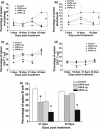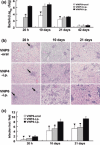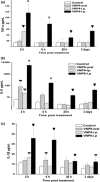Oral delivery of tumor-targeting Salmonella exhibits promising therapeutic efficacy and low toxicity
- PMID: 19793349
- PMCID: PMC11159130
- DOI: 10.1111/j.1349-7006.2009.01337.x
Oral delivery of tumor-targeting Salmonella exhibits promising therapeutic efficacy and low toxicity
Abstract
Tumor-targeting bacteria have been developed as powerful anticancer agents. Salmonella typhimurium VNP20009, a representative tumor-targeting strain, has been systemically administered as a single-agent therapy at doses of 1 x 10(6) to 3 x 10(6) colony-forming unit (cfu)/mouse, or in combination with other antitumor agents at doses of 1 x 10(4) to 2 x 10(5) cfu/mouse. Recently, we reported that oral delivery of VNP20009 at the dose of 1 x 10(9) cfu/mouse induced significant anticancer effects comparable to that induced by systemic administration of this strain at 1 x 10(4) cfu/mouse. To further address the efficacy and safety of oral administration of bacteria, here we performed a systemically comparative analysis of anticancer efficacy and toxicity of VNP20009 administered: (i) orally at a dose of 1 x 10(9) cfu/mouse (VNP9-oral); (ii) intraperitoneally at a dose of 1 x 10(4) cfu/mouse (VNP4-i.p.); or (iii) intraperitoneally at a dose of 1 x 10(6) cfu/mouse in tumor-free and tumor-bearing murine models. The results showed that VNP9-oral, similar to VNP4-i.p., induced significant tumor growth inhibition whereas VNP6-i.p. induced better anticancer effect in the B16F10 melanoma model. Among three treatments, VNP9-oral induced the mildest and reversible toxicity whereas VNP6-i.p. resulted in the most serious and irreversible toxicities when compared to other two treatments. Moreover, the combination of VNP9-oral with a low dose of chemotherapeutics produced comparable antitumor effects but displayed significantly reduced toxicity when compared to VNP6-i.p. The findings demonstrated that oral administration, as a novel avenue in the application of bacteria, is highly safe and effective. Moreover, the present preclinical study should facilitate the optimization of bacterial therapies with improved anticancer efficacy and reduced adverse effects in future clinical trials.
Figures

 ) P < 0.05, () P < 0.01, and *P < 0.001, combination group versus VNP6‐i.p.
) P < 0.05, () P < 0.01, and *P < 0.001, combination group versus VNP6‐i.p.
 ) P < 0.05, () P < 0.01, and *P < 0.001 when compared to VNP6‐i.p.
) P < 0.05, () P < 0.01, and *P < 0.001 when compared to VNP6‐i.p.
 ) P < 0.05 and () P < 0.01 when compared to controls.
) P < 0.05 and () P < 0.01 when compared to controls.

 ) P < 0.05, () P < 0.01, and *P < 0.001 when compared to VNP6‐i.p.
) P < 0.05, () P < 0.01, and *P < 0.001 when compared to VNP6‐i.p.
 ) P < 0.05, () P < 0.01, and *P < 0.001 when compared to controls.
) P < 0.05, () P < 0.01, and *P < 0.001 when compared to controls.
Similar articles
-
Attenuated Salmonella VNP20009 mutant (ΔhtrA) is a promising candidate for bacteria-mediated tumour therapy in hosts with TNFR1 deficiency.Lett Appl Microbiol. 2018 Jul;67(1):97-103. doi: 10.1111/lam.12999. Epub 2018 May 24. Lett Appl Microbiol. 2018. PMID: 29698572
-
Oral delivery of tumor-targeting Salmonella for cancer therapy in murine tumor models.Cancer Sci. 2007 Jul;98(7):1107-12. doi: 10.1111/j.1349-7006.2007.00503.x. Epub 2007 May 13. Cancer Sci. 2007. PMID: 17498202 Free PMC article.
-
A phase I trial of genetically modified Salmonella typhimurium expressing cytosine deaminase (TAPET-CD, VNP20029) administered by intratumoral injection in combination with 5-fluorocytosine for patients with advanced or metastatic cancer. Protocol no: CL-017. Version: April 9, 2001.Hum Gene Ther. 2001 Aug 10;12(12):1594-6. Hum Gene Ther. 2001. PMID: 11529249 Clinical Trial.
-
Therapeutic vaccines based on genetically modified Salmonella: a novel strategy in cancer immunotherapy.Pol Arch Med Wewn. 2011 Dec;121(12):461-6. Pol Arch Med Wewn. 2011. PMID: 22129784 Review.
-
Salmonella and cancer: from pathogens to therapeutics.Acta Biochim Pol. 2013;60(3):285-97. Epub 2013 Jul 5. Acta Biochim Pol. 2013. PMID: 23828775 Review.
Cited by
-
Camouflaging attenuated Salmonella by cryo-shocked macrophages for tumor-targeted therapy.Signal Transduct Target Ther. 2024 Jan 10;9(1):14. doi: 10.1038/s41392-023-01703-1. Signal Transduct Target Ther. 2024. PMID: 38195682 Free PMC article.
-
Salmonella-Based Therapy Targeting Indoleamine 2,3-Dioxygenase Coupled with Enzymatic Depletion of Tumor Hyaluronan Induces Complete Regression of Aggressive Pancreatic Tumors.Cancer Immunol Res. 2015 Sep;3(9):1096-107. doi: 10.1158/2326-6066.CIR-14-0214. Epub 2015 Jul 1. Cancer Immunol Res. 2015. PMID: 26134178 Free PMC article.
-
Autonomous bacterial nanoswimmers target cancer.J Control Release. 2017 Jul 10;257:68-75. doi: 10.1016/j.jconrel.2016.10.006. Epub 2016 Oct 12. J Control Release. 2017. PMID: 27744036 Free PMC article.
-
Myeloid-derived suppressor cells: a double-edged sword?Int J Exp Pathol. 2011 Apr;92(2):73-8. doi: 10.1111/j.1365-2613.2010.00754.x. Epub 2011 Feb 12. Int J Exp Pathol. 2011. PMID: 21314739 Free PMC article. Review.
-
Oncolytic bacteria VNP20009 expressing IFNβ inhibits melanoma progression by remodeling the tumor microenvironment.iScience. 2024 Mar 2;27(4):109372. doi: 10.1016/j.isci.2024.109372. eCollection 2024 Apr 19. iScience. 2024. PMID: 38510114 Free PMC article.
References
-
- Pawelek JM, Low KB, Bermudes D. Bacteria as tumour‐targeting vectors. Lancet Oncol 2003; 4: 20–8. - PubMed
-
- Zhao M, Yang M, Ma HY et al. Targeted therapy with a Salmonella typhimurium leucine‐arginine auxotroph cures orthotopic human breast tumors in nude mice. Cancer Res 2006; 66 (15): 7647–52. - PubMed
Publication types
MeSH terms
Substances
LinkOut - more resources
Full Text Sources
Other Literature Sources

